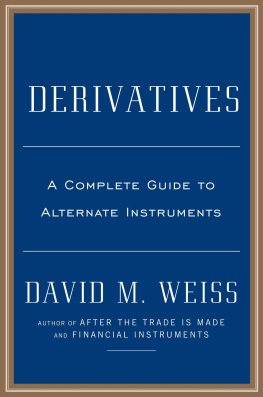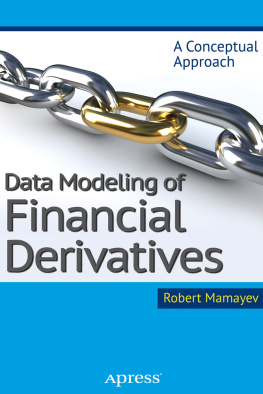
Copyright 2016 by John Wiley & Sons, Inc. All rights reserved
Published by John Wiley & Sons, Inc., Hoboken, New Jersey
Published simultaneously in Canada
No part of this publication may be reproduced, stored in a retrieval system, or transmitted in any form or by any means, electronic, mechanical, photocopying, recording, scanning, or otherwise, except as permitted under Section 107 or 108 of the 1976 United States Copyright Act, without either the prior written permission of the Publisher, or authorization through payment of the appropriate per-copy fee to the Copyright Clearance Center, Inc., 222 Rosewood Drive, Danvers, MA 01923, (978) 750-8400, fax (978) 750-4470, or on the web at www.copyright.com. Requests to the Publisher for permission should be addressed to the Permissions Department, John Wiley & Sons, Inc., 111 River Street, Hoboken, NJ 07030, (201) 748-6011, fax (201) 748-6008, or online at http://www.wiley.com/go/permission.
Limit of Liability/Disclaimer of Warranty: While the publisher and author have used their best efforts in preparing this book, they make no representations or warranties with respect to the accuracy or completeness of the contents of this book and specifically disclaim any implied warranties of merchantability or fitness for a particular purpose. No warranty may be created or extended by sales representatives or written sales materials. The advice and strategies contained herein may not be suitable for your situation. You should consult with a professional where appropriate. Neither the publisher nor author shall be liable for any loss of profit or any other commercial damages, including but not limited to special, incidental, consequential, or other damages.
For general information on our other products and services or for technical support, please contact our Customer Care Department within the United States at (800) 762-2974, outside the United States at (317) 572-3993 or fax (317) 572-4002.
Wiley also publishes its books in a variety of electronic formats. Some content that appears in print may not be available in electronic formats. For more information about Wiley products, visit our web site at www.wiley.com.
Library of Congress Cataloging-in-Publication Data
Sacks, Jana.
Elementary financial derivatives : a guide to trading and valuation with applications / Jana Sacks, Ph.D.
pages cm
Includes bibliographical references and index.
ISBN 978-1-119-07675-9 (hardback)
1. Derivative securities. I. Title.
HG6024.A3.S2297 2015
332.6457dc23
2015024277
ISBN: 9781119076759
Dedication
To Jonathan
Preface
This book is written to be an easy-to-understand introductory textbook featuring hands-on application of presented theoretical concepts. The intention of the book is to introduce the subject of financial derivatives in an accessible and appealing way. The readers will be learning by doing. In the academic environment, the book is intended to be a textbook for an introductory course in financial derivatives.
The purpose of this book is essentially its focus on simplicity. Financial derivatives are often regarded as financial instruments that are just too complex to comprehend and individual investors tend to shy away. At the same time, market professionals state that financial derivatives trades now constitute about 40% of the overall alternative asset markets. This book offers explanations of complex concepts in the simplest possible form with hands-on applications through problems, case studies, and Microsoft Office Excel-based modules for valuation.
The book covers all the essential parts of the derivatives market. Aside from a section on options, it features sections on swaps and financial engineering concepts applied primarily, but not exclusively, to the futures markets.
The target audience is anyone who is interested in learning about financial derivatives in a relatively short time, such as individuals preparing for the CFA exam. I envision the readership anywhere from business school studentsonline and in-classto individual investors interested in trading options using online trading accounts. After reading this book, investors will be able to better understand and assess their risk exposure and decide whether it is indeed one they are prepared to take.
The material in this book is organized into three parts: forwards and futures, swaps, and options. There is an Instructor's Manual available on the book's companion website hosted by John Wiley & Sons, which includes all solutions to end-of-chapter problems. Instructors may also obtain PowerPoint slides from the website.
Jana Sacks
Acknowledgments
There are a number of people I would like to thank for their encouragement, advice, and suggestions. I would like to thank my academic colleagues at St. John Fisher College; my mentorsrecognizing the late Dr. Salih Neftci in particular; industry practitionersKatrina Bell and Ira Jersey; and my research assistantsGarrett MacDonald and Daniela Stefanovski.
I would also like to extend my special thanks to my wonderful family including my canine writing companionsMoses and Buddy.
Table of Figures
Long Position with Futures Price of $100
Short Position with Futures Price of $100
Limit Terminology
Margin Terminology
Long Futures Replication
Short Bond Cash Flows: Borrower
Long Bond Cash Flows: Lender
Cash Flow Diagram for Forward Loan
Replication of a Forward Loan
Deposit
Short Two-Period Bond
Forward Loan
FRA Float Against Fix Cash Flows
Floating Rate Deposit
Fixed Rate Loan
EUR/USD Currency Forward
Long USD Bond
Short EUR Bond
Spot Transaction of Purchasing USD Against EUR
Spot Purchase of EUR
Long EUR-Denominated Bond
Forward Contract: Selling EUR Against USD
Long USD-Denominated Zero-Coupon Bond
Spot Purchase of CHF Against TWD
Spot Purchase of USD Against TWD
Spot Purchase of CHF Against USD
List of Ways to Terminate a Swap
Interest Rate Swap Cash Inflows and Outflows
IRS: Fixed Payer at 6% Against 10-Year LiborCounterparty A
IRS: 10-Year Libor Payer Against 6% FixedCounterparty B
Equity Swap: Floating Against Floating
Counterparty A: Cash Flows
Counterparty B: Cash Flows
Firm A's Cash Flows
Firm B's Cash Flows
FX Swap: Purchase EUR, Pay USD
Financial Engineering of Basis Swap
Financial Engineering of Credit Default Swap
Long Position in a Defaultable Bond
Default-Free Floating Rate Loan
Cash Flows from Combining Defaultable Bond with Default-Free Loan
IRS: Pay Fixed, Receive Float
CDS Spread
Long Call Option Payoff Function at Expiration Time
Short Call Option Payoff Function at Expiration, X = $50, C = $4.30
Long Put Option Payoff Function at Expiration Time
Short Put Option Payoff Function at Expiration Time
Protective Put
Covered Call
Bull Spread
Bear Spread
Call Butterfly Spread, Underlying GM
Put Butterfly Spread, Underlying JCI
Condor
Long Straddle
Short Straddle
Long Strangle
Short Strangle
One-Period Binomial Tree
One-period Asset Price Binomial Tree
The Current Call Option Price is the Probability-weighed Present Value of the Future Call Prices
One Period Binomial Tree for a Call Option
Overvalued Call
Undervalued Call
Stock Price Two-Period Binomial Tree
Call Price Tree
Put Price Tree
Hedge Ratio Tree
Next page










